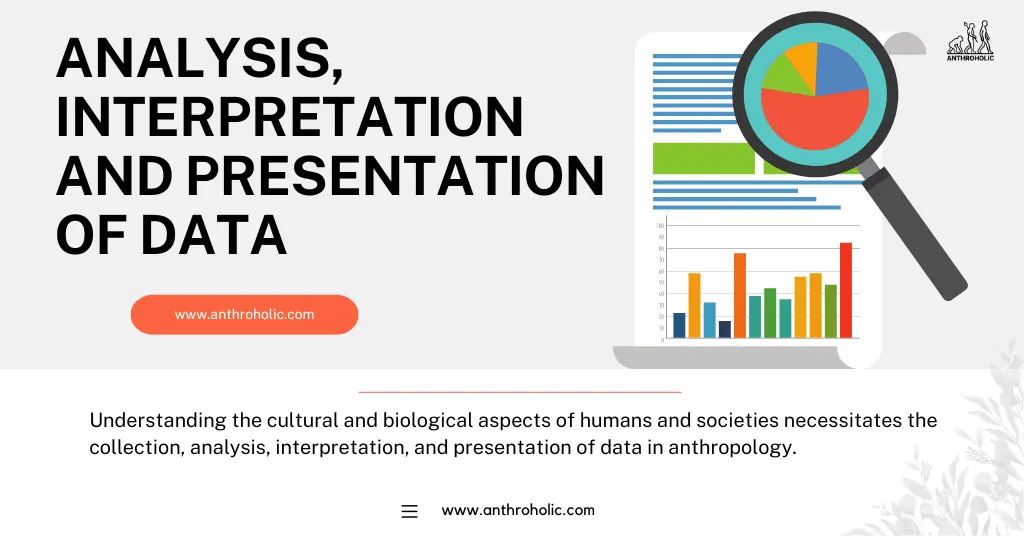AI Answer Evaluation Platform Live Now. Try Free Answer Evaluation Now
Analysis interpretation and presentation of data
Understanding the cultural and biological aspects of humans and societies necessitates the collection, analysis, interpretation, and presentation of data in anthropology.

Data Collection
The first step is to gather data, which in anthropological research often involves both quantitative and qualitative methods [1].
- Quantitative data includes statistics, measurements, and anything else that can be counted or measured objectively. Examples include population sizes, household incomes, or demographic data.
- Qualitative data often comes from interviews, participant observations, and document analyses. This can include descriptions of rituals, cultural practices, or personal stories.
| Quantitative Data | Qualitative Data | |
|---|---|---|
| Definition | Data that can be measured or counted. | Data that captures descriptive information. |
| Examples | Population sizes, household incomes. | Ritual descriptions, cultural practices. |
Data Analysis
Once data has been collected, the next step is to analyze it. This process is twofold:
- Statistical analysis: Involves making sense of quantitative data. This can include computing averages, determining statistical significance, and identifying correlations [2].
- Thematic analysis: Used for qualitative data. Researchers identify and examine patterns or themes in the data. This can involve coding responses, categorizing data, and looking for overarching themes [3].
Data Interpretation
Interpretation is a crucial step where the researcher makes sense of the analyzed data. In anthropology, interpretation is guided by the research question and theoretical framework.
For instance, a researcher studying gender roles in a specific culture might interpret data on household tasks distribution within the context of gender theories. Or, an anthropologist examining artifact distribution in an archaeological site might interpret their findings in light of theories about trade and exchange in prehistoric societies.
The key is to integrate the findings into a broader anthropological understanding and theoretical context, keeping an open mind for alternative interpretations [4].
Data Presentation
The final step in the process is presenting the data. The mode of presentation can vary greatly depending on the audience, the nature of the research, and the medium of communication.
For example, a research paper might include detailed charts, graphs, and tables of quantitative data, along with descriptions and excerpts of qualitative data. An oral presentation might involve more visual aids like photos or videos, and simpler, more straightforward visual representations of quantitative data.
Visualizing Data
Visualizing data is an important aspect of data presentation. Well-constructed visual aids can simplify complex data and facilitate understanding. In anthropological research, maps, graphs, photographs, and videos can all be used effectively [5].
| Pros | Cons | |
|---|---|---|
| Maps | Convey spatial relationships | Requires good cartographic skills |
| Graphs | Show trends and correlations | Can be misinterpreted without proper context |
| Photographs | Provide rich contextual details | Require consent and ethical consideration |
| Videos | Capture dynamic processes | Require technical skills and can be time-consuming to produce |
Remember, the ultimate goal is not just to present the raw data, but to communicate the meaning and significance of the findings.
The Importance of Rigor in Data Handling
Rigor is a fundamental pillar of any research, but in anthropology, where the subject matter often includes deeply personal and nuanced cultural experiences, it is especially crucial. Researchers must ensure that they are consistently transparent, meticulous, and fair in their data handling [6].
- Consistency and Transparency: Consistency in data analysis and interpretation is crucial for maintaining the validity of research findings. This means applying the same rules and criteria throughout the analysis. Transparency in the process is also essential so that others can understand and replicate the research methodology [7].
- Meticulousness: Paying close attention to detail in the analysis process can reveal patterns and nuances that could otherwise be overlooked. This is especially true in qualitative research where small details in an interview transcript or a field note can yield significant insights.
- Fairness: Anthropologists have a responsibility to represent their research subjects fairly and accurately. This means not allowing personal biases to cloud their analysis and interpretation, and ensuring that their findings are communicated in a way that respects and maintains the dignity of the individuals and cultures being studied [8].
The Use of Technology in Data Analysis, Interpretation, and Presentation
The advancements in technology have had significant impacts on the way anthropologists handle data. Software for statistical analysis, data visualization tools, and digital platforms for data presentation have become integral parts of the research process.
Software for Statistical Analysis
Programs such as SPSS, R, and Python have provided researchers with powerful tools for managing and analyzing quantitative data [9]. These software programs allow anthropologists to conduct complex statistical analyses, manage large datasets, and visualize their data in innovative ways.
Digital Platforms for Data Presentation
The use of digital platforms for data presentation has opened up new possibilities for anthropologists to share their research with wider audiences. These platforms allow researchers to create interactive maps, infographics, and other dynamic visualizations that can significantly enhance the presentation and understanding of their findings [10].
Conclusion
In the end, the value of anthropological research is determined by the rigour of its data handling, from collection and analysis to interpretation and presentation. Whether examining the nuances of cultural practices or studying trends in biological data, anthropologists rely on a systematic approach to data handling to generate insights about the human experience.
References
[1] Bernard, H. R. (2011). Research methods in anthropology: Qualitative and quantitative approaches. AltaMira Press.
[2] Guest, G., Namey, E., & Mitchell, M. (2012). Collecting qualitative data: A field manual for applied research. Sage.
[3] Boyatzis, R. E. (1998). Transforming qualitative information: Thematic analysis and code development. Sage.
[4] Gravlee, C. C. (2015). How race becomes biology: Embodiment of social inequality. American Journal of Physical Anthropology.
[5] Pink, S. (2013). Doing visual ethnography. Sage.
[6] Lecompte, M. D., & Goetz, J. P. (1982). Problems of reliability and validity in ethnographic research. Review of Educational Research, 52(1), 31-60.
[7] Morse, J. M., Barrett, M., Mayan, M., Olson, K., & Spiers, J. (2002). Verification strategies for establishing reliability and validity in qualitative research. International journal of qualitative methods, 1(2), 13-22.
[8] American Anthropological Association (2009). Code of Ethics of the American Anthropological Association. http://www.aaanet.org/issues/policy-advocacy/upload/AAA-Ethics-Code-2009.pdf
[9] Marwick, B., & Birch, S. (2018). A standard for the scholarship: Computational reproducibility in archaeological research. Advances in Archaeological Practice, 6(3), 236-247.
[10] Huggett, J. (2017). The apparatus of digital archaeology. Internet Archaeology, (44).




